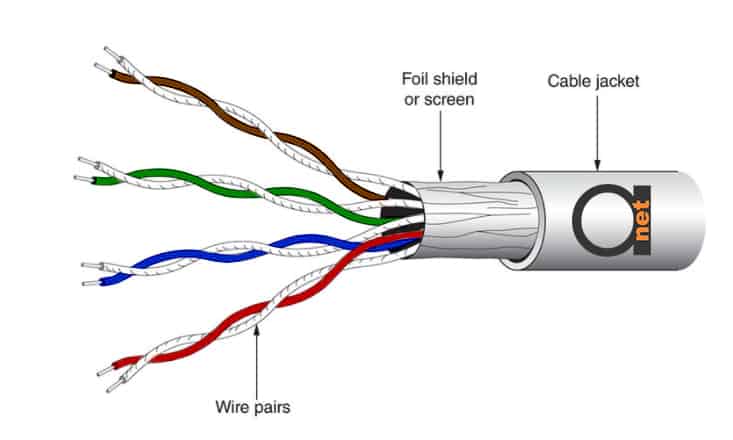Screened Twisted-Pair (ScTP)
Screened twisted-pair (ScTP) cabling is recognized by the AN 51 / TIA-568-C standard.
This is a hybrid of UTP and STP cable. ScTP cable typically consists of four pairs of 100 ohm, 24 AWG wire that are unshielded, but surrounded by a shield of foil and includes a single drain wire used for grounding.

Figure 1: Screened twisted-pair (ScTP)
ScTP is therefore also called FTP (foil twisted-pair), as a foil shield surrounds the conductors. The foil shield is typically smaller than the woven copper braided jacket used by STP cabling systems. ScTP cable is basically STP cabling without the individual pairs being shielded. The shield is also often smaller than some types of STP cabling.
ScTP is less susceptible to noise because of the foil shield.
When implementing an effective ScTP system however, the shield’s continuity should be kept through the whole channel, including wall plates, patch panels and patch cords. Yes, that’s correct – not only should the wires’ continuity be maintained through connections, but also the shield’s continuity.
As with STP cabling, the system must be connected to ground at both ends of each cable run. If this is not done, a massive antenna is effectively created with a frequency inversely proportional to the shield length. The overall effect is that the noise generated is out of band.
Standard eight pole modular jacks (commonly called RJ-45) can’t ensure a proper ground through the cable shield, so special patch panels, jacks, mating hardware and tools must be used to install a ScTP cabling system. There are many manufacturers of ScTP cable and components, but make sure you follow all installation guidelines.
ScTP is typically used in environments that have an abnormally high level of ambient electromagnetic interference, including hospitals, industrial work spaces, airports, and government and military communications centers. ScTP is also for example used in restaurants where wireless headsets are used by workers, as various wireless frequencies interfere with Ethernet over copper. Good to remember when you use our LAN extenders family.
The value of a ScTP system in relation to its higher cost is often questioned, as tests indicate that the noise immunity and emission characteristics of UTP are comparable with ScTP. The decision to use ScTP often boils down to simply having the secure feeling of knowing that an extra shield has been installed.
Screened Shielded Twisted-Pair (S/STP or S/FTP)
Screened Shielded Twisted-Pair cabling, is also called screened fully shielded twisted-pair (S/FT) and it consists of four individually shielded pairs of 100 ohm, 24 AWG, wire surrounded by an outer sheath of metal covering all the shielded copper pairs. This eliminates alien crosstalk and provides excellent protection from interference from any external source. This allows for higher speed networks.
Category 7 and 7A cables are S/STP cabled mentioned in ISO 11801 Ed. 2.2. These cables offer a bandwidth of 600 and 1,000MHz respectively and are intended to be used for 10 Gigabit Ethernet, 10GBase-T applications.
Wanted to read also about STP cable? Here we have separate article on STP cables.


